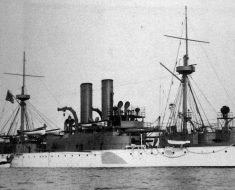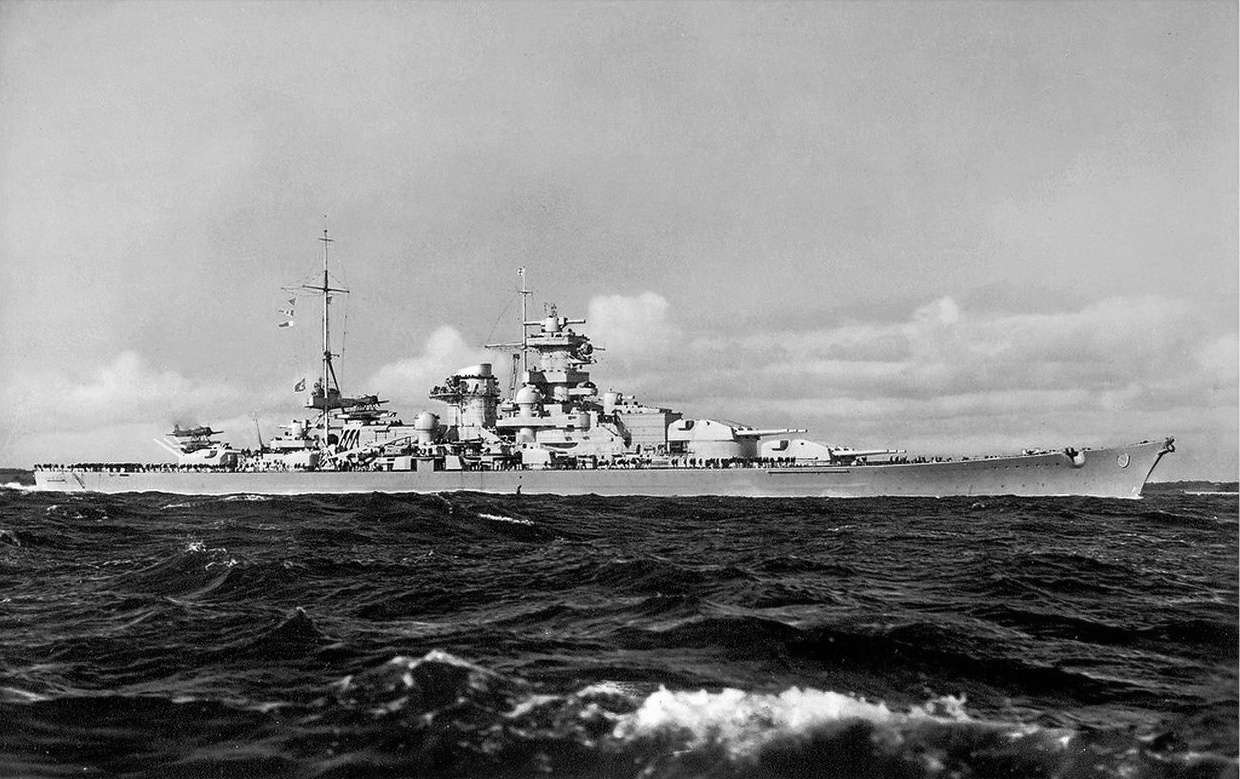The USS Minneapolis (CA-36), a New Orleans-class heavy cruiser, played a pivotal role in the Pacific Theater during World War II, participating in major battles including the Battle of the Coral Sea, Midway, and the Guadalcanal Campaign.
The cruiser famously underwent emergency repairs using coconut logs after severe torpedo damage in the Battle of Tassafaronga, showcasing the ingenuity of its crew.
Contents
- Design of the USS Minneapolis
- Her Early Service
- The Battle of Tassafaronga
- A Bow Made of Coconut Trees…
- Reapirs and Later Service of the USS Minneapolis
- Fate of the USS Minneapolis
Design of the USS Minneapolis
The USS Minneapolis (CA-36) ws a New Orleans-class heavy cruiser. Its design and construction were shaped by the limitations and allowances of the Washington Naval Treaty of 1922 and the London Naval Treaty of 1930, which aimed to prevent a naval arms race by imposing restrictions on the tonnage and armament of ships.
Read More The USS Texas ‘Sank’ Herself on D-Day
The New Orleans-class cruisers were designed to optimize firepower, protection, and speed within the constraints of treaty limitations. The USS Minneapolis, like its sister ships, was constructed to displace no more than 10,000 tons, a restriction aimed at ensuring a balance of naval power. This limitation influenced every aspect of her design, from hull dimensions to armament and armor.
The USS Minneapolis was armed with a main battery of nine 8-inch/55 caliber guns in three triple turrets, two forward and one aft, which constituted the ship’s primary offensive capability. These guns were capable of firing heavy shells at targets up to 17,000 yards away, making them formidable tools against enemy surface vessels.
For defense against aircraft, the cruiser was equipped with eight 5-inch/25 caliber anti-aircraft guns, along with an array of smaller guns and machine guns that were updated throughout her service life. Additionally, the Minneapolis was fitted with torpedo tubes, enhancing her versatility in combat.
The protection scheme of the Minneapolis was designed to withstand gunfire and torpedo attacks, a critical consideration given the cruiser’s role in engaging enemy surface ships and providing fleet air defense.
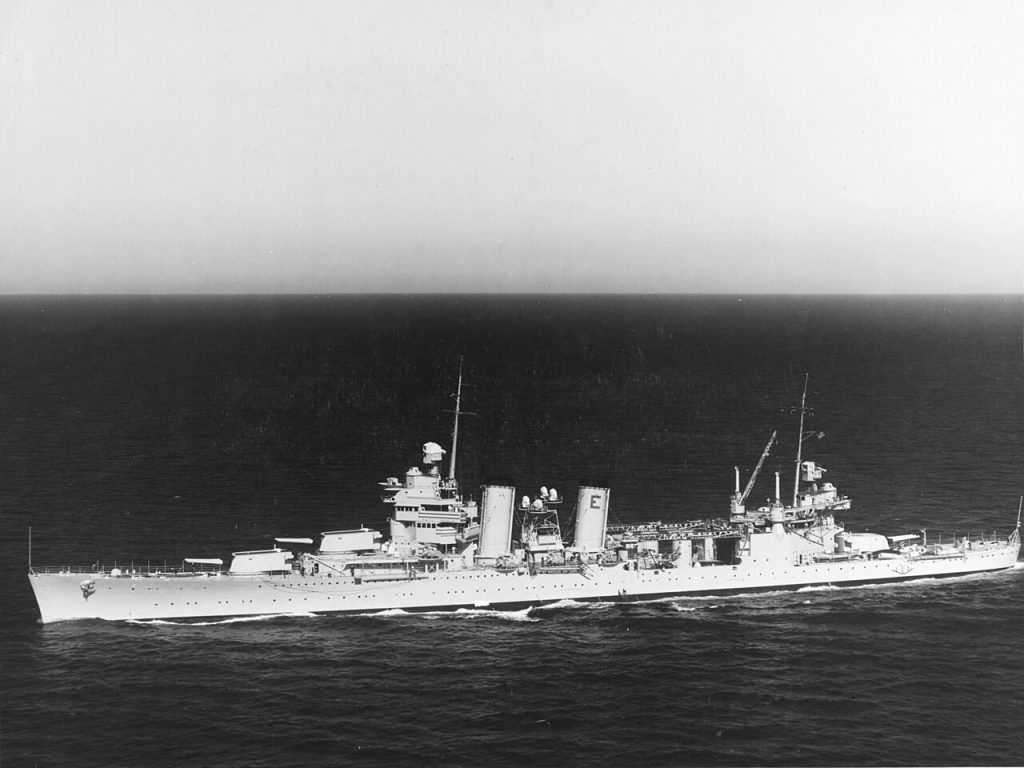
Her armor belt, constructed of high-tensile steel, varied in thickness to protect vital areas, while the deck armor was designed to guard against aerial bombs and plunging fire. The ship’s vital machinery and ammunition magazines were further protected by an intricate system of armored bulkheads and protective decks.
Powered by four Parsons geared turbines and eight boilers, the Minneapolis was capable of reaching speeds in excess of 32 knots. This propulsion system provided the speed and range necessary for the cruiser to fulfill its roles in reconnaissance, escort duties, and the fast-paced operations of fleet actions. The ship’s design also emphasized fuel efficiency and endurance, allowing it to operate across the vast distances of the Pacific Theater.
The USS Minneapolis was laid down at the Philadelphia Naval Shipyard on June 27, 1931, launched on September 6, 1933, and commissioned into service on May 19, 1934. Her construction incorporated the latest advancements in naval engineering and materials science of the time, including the use of welding to reduce weight and increase structural integrity.
Read More The Turret Explosion on the USS Iowa
The ship’s design also allowed for future modifications and upgrades, a foresight that proved invaluable during World War II, as the demands of combat necessitated enhancements in armament, armor, and technology.
Her Early Service
Launched in 1933 and commissioned in 1934, the USS Minneapolis was designed to be a formidable asset to the U.S. naval forces. Following its commissioning, the cruiser participated in a variety of peacetime operations, including training exercises, goodwill visits, and fleet maneuvers, which were critical in demonstrating American naval power and preparedness during the interwar period.
As tensions escalated globally in the late 1930s, the Minneapolis, along with other units of the U.S. Navy, found itself increasingly involved in “Neutrality Patrols” in the Atlantic. These patrols were intended to deter Axis aggression and protect American interests and shipping.
Read More USS Borie Vs U-405 – One of the Craziest Battles of WWII
With the Japanese attack on Pearl Harbor on December 7, 1941, the United States entered World War II, and the USS Minneapolis was thrust into active combat operations in the Pacific Theater. The cruiser played a significant role in several key battles and campaigns across the Pacific, leveraging its firepower, speed, and armor to engage enemy forces and support Allied operations.
One of the early notable actions of the USS Minneapolis during World War II was its participation in the Battle of the Coral Sea in May 1942. This engagement was crucial as it marked the first time in naval history that a sea battle was fought entirely by aircraft from carriers, with the opposing ships never coming into sight of each other. The Minneapolis provided anti-aircraft cover and was ready for surface action, contributing to the strategic success of preventing a Japanese invasion of Port Moresby, New Guinea.
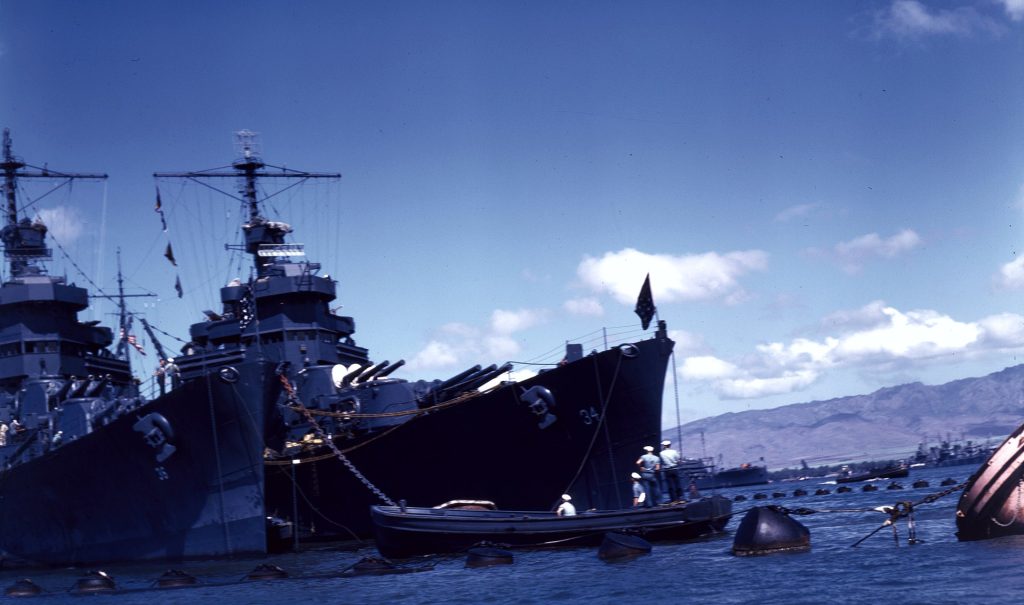
Following the Coral Sea, the Minneapolis was involved in the pivotal Battle of Midway in June 1942. Though primarily a carrier battle, the Minneapolis was part of the task force that provided crucial support and was prepared to engage in surface combat if the opportunity arose. The victory at Midway was a turning point in the Pacific War, halting Japanese expansion and beginning a series of Allied offensives.
The Battle of Tassafaronga
Perhaps one of the most challenging engagements for the USS Minneapolis was the Battle of Tassafaronga.
The Battle of Tassafaronga, fought on the night of November 30, 1942, was a naval engagement during the Guadalcanal Campaign. This confrontation took place in Ironbottom Sound, off the coast of Guadalcanal in the Solomon Islands.
Read More 3 Sailors Were Trapped in the West Virginia for 16 Days After the Pearl Harbor Attack
The U.S. Navy, under the command of Rear Admiral Carleton H. Wright, aimed to intercept and destroy a Japanese convoy led by Rear Admiral Raizo Tanaka. The convoy was tasked with delivering food and ammunition to Japanese forces on Guadalcanal. The U.S. had a cruiser force consisting of five cruisers and four destroyers, while the Japanese convoy was composed of eight destroyers, several of which were carrying supplies.
The battle was notable for the effective use of torpedo tactics by the Japanese against the American cruisers. Despite being outgunned, the Japanese managed to inflict heavy damage on the U.S. Navy, sinking one cruiser (USS Northampton) and severely damaging three others (USS Minneapolis, USS New Orleans, and USS Pensacola) with torpedoes. The Japanese, in contrast, suffered relatively minor damage to one destroyer (the Takanami, which was eventually sunk).
The outcome of the battle was a tactical victory for the Japanese, as they successfully delivered the supplies to Guadalcanal and inflicted significant losses on the U.S. cruisers with minimal losses. However, strategically, it did little to alter the course of the campaign in the Solomon Islands.
Read More A US Destroyer Fired a Torpedo at the USS Iowa While the President was on Board
The battle underscored the effectiveness of nighttime torpedo attacks and highlighted deficiencies in American radar technology and tactics, leading to improvements in both areas in the subsequent months of the war.
A Bow Made of Coconut Trees…
During the battle, the USS Minneapolis sustained severe damage, including a torpedo hit that severely damaged its bow, along with a second the struck her port side. The damage was critical and required innovative emergency repairs to make the ship seaworthy enough to return to a major shipyard for permanent repairs.
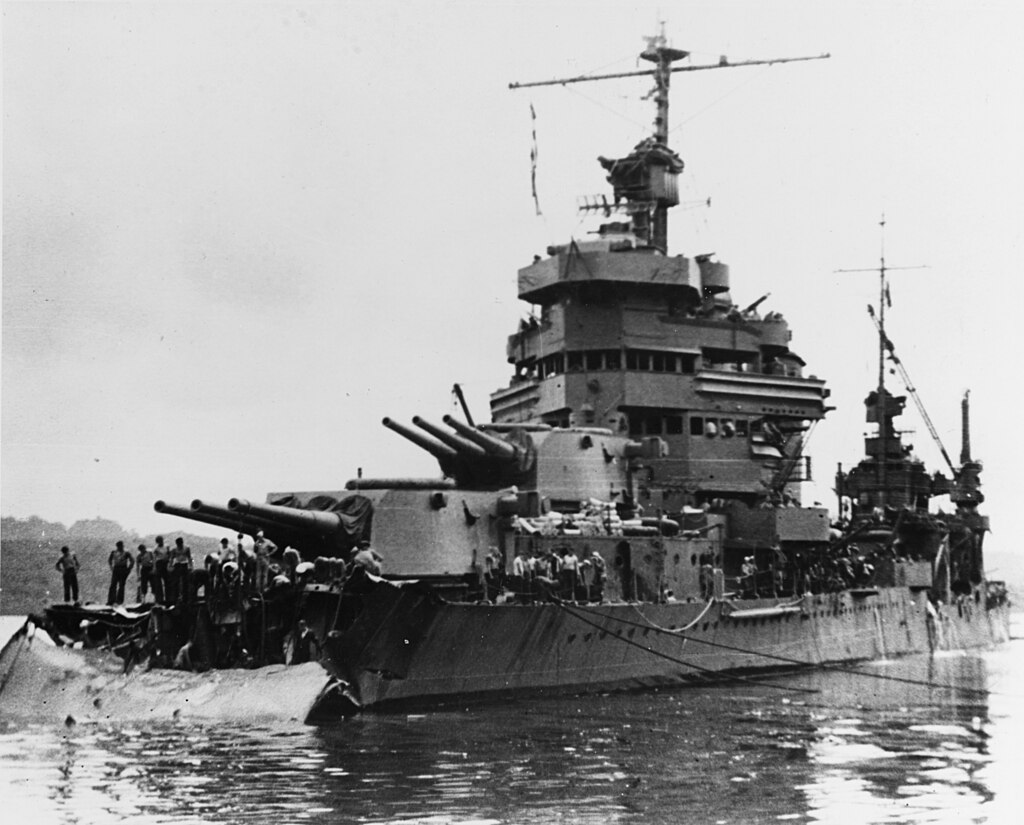

To address this, the crew of the USS Minneapolis came up with an ingenious solution. They utilized materials that were readily available in their surroundings – coconut logs.

The logs were used to create a makeshift replacement for the bow. By shoring up the damaged bow with coconut logs and other materials, they were able to provide enough buoyancy and structural integrity to navigate the ship back for permanent repairs.
This temporary solution was critical in saving the ship and allowing it to arrive in Tulagi to undergo temporary repairs. She would then make her way to Mare Island, with one stop at Espiritu Santo for another repair job.

Repairs and Later Service of the USS Minneapolis
Upon reaching Mare Island in the United States, the USS Minneapolis underwent extensive repairs and modifications. The damaged bow was completely rebuilt, and during this period, the opportunity was taken to upgrade the cruiser’s weaponry and defensive systems. This included enhancing anti-aircraft capabilities to address the increasing threat from Japanese aircraft.
Read More The Port Chicago Disaster – The Largest Homeland Disaster During World War II
After repairs and upgrades, the USS Minneapolis returned to active duty in the Pacific with renewed capabilities. The cruiser rejoined the fight at a critical time when Allied forces were pushing forward with major offensives across the Pacific islands.
The Minneapolis played a significant role in these operations, providing naval gunfire support for amphibious landings, escorting carrier groups, and engaging enemy surface forces. Its actions contributed to the liberation of occupied territories and the eventual defeat of Japan.
Following its return to combat, the Minneapolis participated in several key operations. This included actions in the Marshall Islands campaign, where the cruiser supported the capture of Kwajalein and Eniwetok. In the Marianas campaign, it provided fire support during the invasions of Saipan, Tinian, and Guam, proving critical in the success of these landings.

The cruiser also played a role in the Philippines campaign, supporting the landings at Leyte and participating in the Battle of Surigao Strait, one of the last great battleship engagements in history.
After the end of World War II, the USS Minneapolis continued to serve in a peacetime navy, undergoing further modifications and participating in training exercises and goodwill missions.
Fate of the USS Minneapolis
Following its distinguished service during World War II, the USS Minneapolis, like many combat veterans of its era, transitioned to a post-war role that reflected the changing priorities and strategic needs of the United States Navy in the immediate aftermath of the conflict. This period was characterized by decommissioning older ships, reserves activation, and focusing on new technological advancements, including nuclear power and missile technology.
Read More Temper, Temper – That Time the USS Wisconsin Wasn’t Messing Around
The USS Minneapolis was decommissioned on 10 February 1947, after a brief period of post-war service. The ship was placed in the reserve fleet, where it remained until stricken from the Naval Vessel Register on 1 March 1959. Ultimately, like many ships of its era, the Minneapolis was sold for scrap in 1959, marking the end of its physical presence but not its historical significance.

